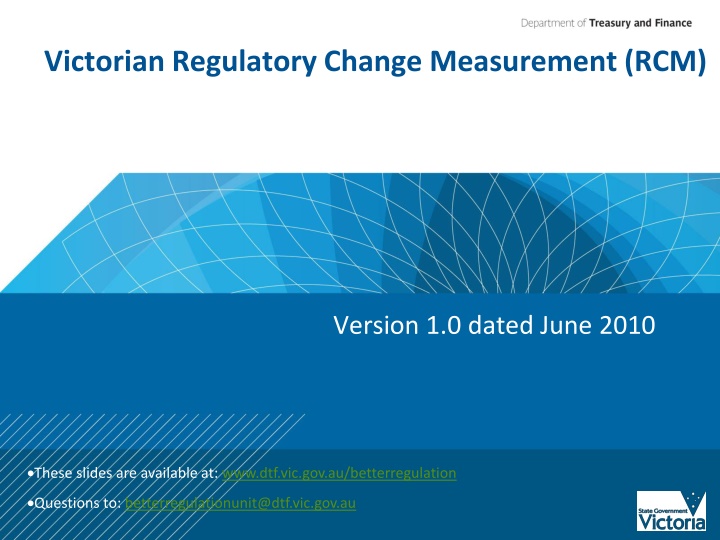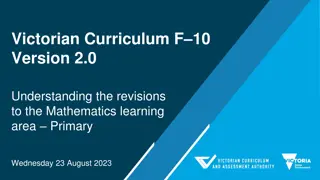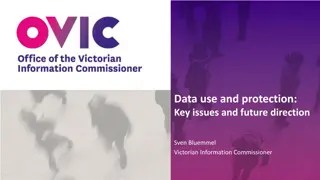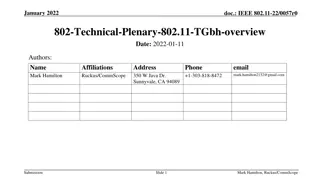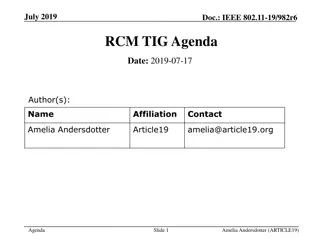Victorian Regulatory Change Measurement (RCM)
The Victorian Regulatory Change Measurement (RCM) methodology introduced in June 2010 aims to measure reductions in regulatory burden through different categories such as administrative costs, substantive compliance costs, delay costs, and more. The RCM formula helps in calculating the total regulatory costs per business affected by the change. The methodology provides a detailed overview of the Reducing the Regulatory Burden (RRB) initiative and offers technical toolkits for implementation.
Download Presentation

Please find below an Image/Link to download the presentation.
The content on the website is provided AS IS for your information and personal use only. It may not be sold, licensed, or shared on other websites without obtaining consent from the author.If you encounter any issues during the download, it is possible that the publisher has removed the file from their server.
You are allowed to download the files provided on this website for personal or commercial use, subject to the condition that they are used lawfully. All files are the property of their respective owners.
The content on the website is provided AS IS for your information and personal use only. It may not be sold, licensed, or shared on other websites without obtaining consent from the author.
E N D
Presentation Transcript
Victorian Regulatory Change Measurement (RCM) Version 1.0 dated June 2010 These slides are available at: www.dtf.vic.gov.au/betterregulation Questions to: betterregulationunit@dtf.vic.gov.au
Victorian Regulatory Change Measurement (RCM) Rundown Introduction to the RCM methodology Overview of the Reducing the Regulatory Burden (RRB) initiative Step 2.1: Understanding the scope Step 2.2 to 2.5: Before commencing the measurement Step 2.6.1: Mapping the regulatory change Step 2.6.2: Assessing and calculating costs Step 2.6.3 to 2.8: Finalising the measurement
What? Introduction to the RCM methodology
What is the RCM? Regulatory Change Measurement (RCM) is a methodology to measure reductions in regulatory burden RCM refines and replaces the Victorian Standard Cost Model methodology (focused on administrative costs only) from 1 January 2010 RCM is documented in a manual with two technical toolkits, available at: www.dtf.vic.gov.au/betterregulation
Regulatory costs measured by RCM methodology Administrative costs -Costs incurred primarily to demonstrate compliance with the regulation or to allow government to administer the regulation, e.g. filling in forms Substantive Compliance costs -Costs that directly lead to the regulated outcome, e.g. installing safety device Delay costs -Expenses and loss of income incurred through having to complete an application requirement or wait for an application approval, e.g. waiting for approval of a building permit Details later
Regulatory costs measured by RCM methodology Regulatory costs Financial costs Compliance costs Other costs (e.g. market/competition) Delay costs Substantive compliance costs Administrative costs Impacts of being prevented by administrative process from conducting operations Costs within the red border are measured through the RCM
RCM formula for costs Regulatory costs (total $) X Price (P) Quantity (Q) OR Estimated cost of the regulatory change per business Number of businesses X affected
Some key RCM principles Proportionality of effort -need to keep the cost of measurement in mind Indicative nature of estimates -not a statistically robust measure Transparency of assumptions -all relevant documentation to be disclosed
Some proportionality considerations Regulatory burden change (+/-) $10 m $250k/$500k Medium measurement costs Low measurement costs Cost of conducting the RCM Illustrative implications: Limited More extensive Business interviews Only if needed Business engagement Strongly recommend Activity level only if needed and resources permit Limited Effort to gather data Detail of mapping (to activity level*) Limited effort or referencing More effort to gather data
Why? Overview of the RRB initiative
The Reducing the Regulatory Burden (RRB) initiative Launched in 2006, the RRB initiative target of $256 million in administrative burden reductions, has been increased to a $500 million per annum in burden reduction by July 2012, including: -administrative costs -substantive compliance costs -costs of delays The burden reduction will increase productivity and Victoria s competitiveness by enabling regulated entities to use their time and resources more productively This will make Victoria a more attractive place to do business
How does the RRB initiative deliver its targets? Identify and review regulatory burdens Sources of information: -burden reduction opportunities identified by departments -recommendations from VCEC inquiries -input from business and affected sectors Funding of reviews: -Departmental reviews of sunsetting regulations, and other reforms -by RRU through the RRB Incentive Fund Examples of outputs that reduce burdens -process improvements (e.g. improved forms) -online solutions (e.g. electronic lodgement) -policy review (not mandating risk control plans ) -review of approvals processes (quicker approvals save time) See Treasurer s report for detailed examples
Benefits of measuring regulatory changes Validate effort to reduce the burden on business Prove government leadership in cutting the burden Provides the affected sectors with a transparent measure of the change to burden that is imposed on them
Some key processes Measurement is mandatory for changes in regulation within scope of RRB RCM is a verification exercise, not related to regulatory gate-keeping -RCM report not to be attached to BIA/RIS Independent assessment -Department or agency prepares the RCM Report -VCEC or BRU assesses, as appropriate* *Details later
How? Step 2.1 Understanding the scope
END WAIT up to 3 months from charge RCM not needed START Regulatory change arising from instruments subject to BIA/RIS NO NO Is information available to assess the magnitude of change? Is the regulatory change within scope of RRBE? YES START S2.2 S2.1 Regulatory change arising from instruments not subject to BIA/RIS Understand the magnitude of change S2.3 S2.4 Administrative burden alone $250 000 per annum END Is the change material? NO RCM not needed Administrative burden substantive, compliance costs, and delay costs $500 000 per annum YES RCM is needed Consult with BRU on materiality and further steps S2.5
2.1.1 Regulatory instruments in scope What is regulation? All legally enforceable obligations imposed by Victorian authorities What is regulatory burden? Regulatory burden is that burden over and above business as usual (BAU) -BAU is what the business would do on its own (i.e. without regulation) -BAU is not a regulatory burden Government imposed regulatory costs Baseline (case of no regulation) Business-as- usual costs
BAU: An example Would a construction business erect a scaffold in the absence of regulation? -Virtually none will work without a scaffold -Virtually none will erect a bamboo scaffold in Australia -Most will use strong steel scaffold Hence only the increment of safety requirements over and above what business uses on its own would be treated as a regulatory burden
Examples of regulation within RRB scope State Government regulation: Acts of Parliament Regulations (statutory rules under the Subordinate Legislation Act 1994 (SLA) including court rules Subordinate instruments (that are not a statutory rule under the SLA), such as: Rules, orders, etc by Ministers or agencies Licences and permits Codes of Practice/Guidance/Industry Agreements with government backing State government regulation administered by local government Local Government by laws: A local law within the meaning of Part 5 the Local Government Act 1989 Impacts of harmonisation see details in the Manual
Step 2.1.2 Sectors within scope Business sector Not-for-profit (NFP) sector Economic (income-generating) activities of private individuals -such as employment related activities Government services (a sub-sector of Government) -Direct Government service delivery that is comparable to services delivered by the business or NFP sectors. Examples : education and training services delivered through public schools; health services delivered through public hospitals; ambulance services; public aged care services; and public and community housing.
Step 2.1.3 Regulatory costs within scope All compliance costs -Administrative costs (red tape) -Substantive compliance costs Delay costs Regulatory costs Financial costs Compliance costs Other costs (e.g. market/competition) Delay costs Substantive compliance costs Administrative costs Impacts of being prevented by administrative process from conducting operations
Administrative costs (red tape) Costs incurred by regulated entities primarily to demonstrate compliance with a regulation or to allow the government to administer the regulation Examples: -making, keeping or providing records -preparing plans -conducting tests -making an application -conducting internal audits and inspections -cooperating with Government inspections
Substantive compliance costs Costs that directly lead to the regulated outcomes being sought. These are often capital and production costs. Examples: -training -providing information to third parties -inputs to comply with a plan or test -purchase and maintenance of plant and equipment -operations
Delay costs Delay costs are the expenses and loss of income incurred by a regulated entity through: -an application delay; and/or -an approval delay. Two types -An application delay refers to the time taken by a regulated entity to complete an application (e.g. for a licence or permit) -An approval delay refers to the average time taken by a regulator to communicate a final decision regarding the application and includes a normal level of re-work of the application
Delay costs - discussion Expenses Holding costs of land -Example: Developer holding land for a longer duration than otherwise needed to build Standby costs of capital -Example: A dredger inside Port Philip Bay waiting for approval to commence dredging Standby costs of labour (or labour downtime) -Note that routine form filling is unlikely to generate labour downtime (apart from the time take to fill the form) Example: A worker idle on the dredger from the above example waiting to commence operations Loss of income Lost business opportunities during the delay period
Identification of delay slide 1 Regulatory Process 1 Over-lapping time period with Process 1 Regulatory Process 2 0 1 2 TIME
Identification of delay slide 2 Regulatory Process 1 Time saved by removing Regulatory Process 2 Regulatory Process 2 0 1 2 TIME The reduction in the length of the application process by removing RP2 is only equal to the section between time 1 and time 2 More slides on delays: www.dtf.vic.gov.au/betterregulation
Steps 2.2 to 2.5 Before commencing the measurement
Key steps in the process END WAIT up to 3 months from charge RCM not needed START Regulatory change arising from instruments subject to BIA/RIS NO NO Is information available to assess the magnitude of change? Is the regulatory change within scope of RRBE? YES START S2.1 S2.2 Regulatory change arising from instruments not subject to BIA/RIS Understand the magnitude of change S2.3 S2.4 Administrative burden alone $250 000 per annum END Is the change material? NO RCM not needed Administrative burden substantive, compliance costs, and delay costs $500 000 per annum YES RCM is needed Consult with BRU on materiality and further steps S2.5
Step 2.2 Is information to measure the change available? RCM report to be submitted for assessment within three months of a regulatory change taking effect Where information that is crucial for estimating the magnitude of change is not available within this period, alternative timeframe with RRU can be negotiated
Step 2.3 Understand the magnitude of change A broad application of the measurement approach is used to prepare a plausible initial estimate. Some questions to ask Do these changes: -introduce or abolish information or compliance obligations? -significantly increase or reduce the frequency of reporting or compliance obligations? -introduce a new area of regulation? -affect a large number of regulated entities?
Step 2.4 Is the change material? Materiality test -For administrative burdens on the business and not-for-profit sectors, a change $250,000 per annum. -For the sum of all regulatory costs within the RRB initiative, a combined change $500,000 per annum.
Step 2.4 Is the change material? An RCM is required where there is prima facie evidence that the change in regulatory burden is likely to be material Example : Back-of-the-envelope calculation Where only administrative burden has changed: -250,000 = Price x Quantity -250,000 = Time x Tariff ($60/hour) x Quantity -250,000 / 60 = Time x Quantity -4167 = Time x Quantity (5000 businesses) -4167 / 5000 = Time -0.8334 hours = Time Therefore, if the regulatory change saves more than 50 minutes per business, the change is likely to be material, and an RCM will be needed
Materiality test - 1 Example 1: Initial estimates (costs in $ million) Economic activities of individuals Government services Sector/cost categories Total by cost categories Business NFP Administrative costs +0.2 -0..6 -0.4 Substantive compliance costs Delay costs Total by sector +0.2 -0.4 -0.4 Answer:Yes, this is MATERIAL. This will be counted against the $256 million administrative burden reduction target.
Materiality test - 2 Example 2: Initial estimates (costs in $ million) Economic activities of individuals Government services Sector/cost categories Total by cost categories Business NFP Administrative costs +0.2 -0.6 -0.4 Substantive compliance costs Delay costs Total by sector +0.2 -0.6 -0.4 Answer:No, this is NOT MATERIAL. However, departments may choose to measure and count against the broader $500 million target.
Materiality test - 3 Example 3: Initial estimates (costs in $ million) Economic activities of individuals Government services Sector/cost categories Total by cost categories Business NFP Administrative costs +0.3 -0.3 Substantive compliance costs 0.3 0.3 Delay costs Total by sector +0.3 0.3 0 Answer:Yes, this is MATERIAL. This will be counted against the $256 million administrative burden reduction target.
Materiality test - 4 Example 4: Initial estimates (costs in $ million) Economic activities of individuals Government services Sector/cost categories Total by cost categories Business NFP Administrative costs +0.1 -0.1 Substantive compliance costs -0.3 -0.1 Delay costs Total by sector +0.1 -0.3 -0.4 Answer:No, this is NOT MATERIAL. However, departments may choose to measure and count against the broader $500 million target.
Step 2.5 Contact the Regulation Reform Unit Provide RRU with the indicative estimate RRU will provide appropriate advice on next steps
Step 2.6.1 Mapping the regulatory change Reference: Toolkit 1
An introduction to mapping Purpose: -To identify what has changed -To understand the drivers of the change -To be able to identify costs of the change Principles: -Only map the change -Mapping should be conducted at the broadest level feasible -Diagram showing the changes is useful
Map the regulation Regulatory Instrument This should include information on the high level regulatory instrument down to the specific guidance, where relevant Mapping involves: identifying obligations that require a regulated entity to perform a certain action identifying the type of regulatory costs imposed Obligation The legal requirement that affects a sectors behaviour Information Obligation A description of the administrative burden of the obligation Substantive Compliance Obligation A description of the substantive compliance burden portion of the obligation Details of the Delay Cost A description of the delay cost including the reasons for delay and the burden imposed.
Expanded mapping process (where relevant) Three levels (in principle): Mapping can be conducted up to three levels: (1) obligation, (2) requirement and (3) action (or activity) (as with the Standard Cost Model) Mapping to the obligation level is generally sufficient Disaggregation below this level is only necessary when: -information can not be collected at the obligation level, and -the cost of disaggregation is not excessive Requirement level is almost always unnecessary
Expanded mapping process: illustration Table: Hypothetical example of mapping to obtain a dairy licence Information obligation Data requirement Administrative activity Contact details Obtain accurate information for the form. Milk volume information Gather the information from milk statements Application for licence X ? Amount of licence fee payable Calculate the fee payable. Pay the invoice/make deduction and file receipt
Example: Mapping high risk work licences A requirement to hold a licence for high-risk work is one of the obligations under the Occupational Health and Safety Regulations 2007 (Part 3.6, Division 1, Section 3.6.1). Three types of cost categories can exist under this obligation: -information obligation: information to be submitted to government as part of the licence application; -substantive compliance obligation: cost of obtaining a competency requirement as part of the licence application; and -cause of delay is the applicant earning lower wages while waiting for the licence (this imposes an opportunity cost on the applicant).
Mapping an obligation into cost categories (example cont d) Figure T1.2 Occupational Health and Safety Regulations 2007 Obligation 1 Requirement to hold a licence for high-risk work Substantive compliance obligation Cause of delay Information obligation Potential under-utilised labour after lodgement of licence application Cost of training required to obtain a licence for high-risk work Preparing and submitting the licence documentation Activity 1: Fill form Activity 2: Make payment
Step 2.6.2 Assessing and calculating costs Reference: Toolkit 2
General principles Duration of a regulatory change -Default duration is to be taken as ten years except where the change is implemented over a shorter period Annualising the cost estimates -The measurement is averaged out over the duration -It is not a discounted present value Desktop analysis for the most part
Prepare data collection strategy Identify the data required -use the information from mapping exercise, and -consult the relevant cost formulae (details of formulae explained later) Identify sources of data Document the approach to normally efficient business -Conceptual of costs experienced by an average regulated entity Collect the data
The basic formula for regulatory costs Regulatory costs (total $) X Price (P) Quantity (Q) population Labour tariff and/or external staff Administrative Cost Administrative cost time annual frequency compliance (or uptake) rate One-off cost of a physical asset and/or Annualised depreciation population Substantive Compliance Number of physical assets annual frequency X X X Substantiative Compliance Cost Cost compliance (or uptake) rate Delay cost Interest + opportunity costs Duration of holding population
Price variables for administrative costs Tariff: wage rate plus overheads and on-costs for activities performed Time: hours or minutes to complete administrative activity External tariff: hourly rate or cost of external providers to carry out administrative activities Other costs: e.g. capital cost specifically incurred to comply with information obligation or activity Administrative Cost = Price x Quantity = (tariff x time) x Quantity OR = {internal price (i.e. tariff x time) + external tariff + other significant costs} x Quantity
